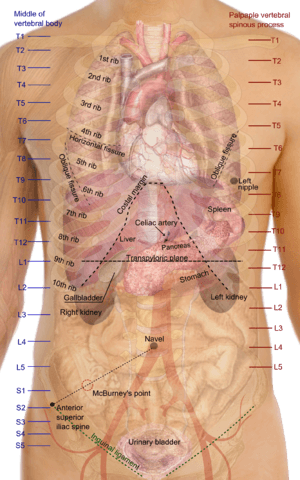Chest facts for kids
Quick facts for kids ThoraxChest |
|
|---|---|
 |
|
| X-ray image of the chest showing the internal anatomy of the rib cage, lungs and heart as well as the inferior thoracic border–made up of the diaphragm. | |
| Latin | thorax |
The thorax or chest is a super important part of your body. It's located between your neck and your tummy. Think of it as a protective box for some of your most vital organs!
Inside your chest, you'll find your heart, lungs, and the thymus gland. There are also many muscles and other structures that help your body work. Sometimes, people can feel chest pain, which can be caused by different things.
Contents
What is the Thorax?
In humans, the thorax is the area of your body between your neck and your abdomen. It holds many important organs and other parts. Your chest is mostly protected by your rib cage, your spine, and your shoulder bones.
Parts Inside Your Chest

Your chest contains many key parts:
- Organs: Your heart, lungs, and thymus gland.
- Muscles: Large and small pectoral muscles, and trapezius muscles.
- Structures: The diaphragm (a muscle that helps you breathe), the esophagus (food pipe), and the trachea (windpipe).
- Blood Vessels: Major arteries like the aorta and veins like the superior vena cava and inferior vena cava.
- Bones: The scapula (shoulder blade), sternum (breastbone), thoracic spine, collarbone, and your ribs.
The Chest Area

When we talk about the "chest" in humans, we usually mean the front part of the thorax, from the neck down to the diaphragm. Animals also have a chest area in the same part of their body.
Bones of the Chest
The bones in your chest are called the "thoracic skeleton." They are a main part of your body's central support system, known as the axial skeleton.
These bones include your ribs and your sternum. You have 12 pairs of ribs, numbered from 1 to 12. The last two pairs, ribs 11 and 12, are sometimes called "floating ribs" because they don't connect to the sternum in the front.
Chest Health
Your chest can be affected by different diseases or conditions. Some common ones include pleurisy (inflammation around the lungs) or atelectasis (a collapsed lung). The most common issue is chest pain. These problems can be passed down in families, be present from birth, or happen because of an injury. Any condition that makes it hard to breathe deeply or to cough is considered a chest problem.
Chest Injuries
Injuries to the chest are also called chest trauma. They are a serious concern and can be very dangerous.
When someone has a chest injury, it can make it hard for air or blood to move properly in the body. For example, if the chest wall is hurt, like with broken ribs, the pain can make breathing difficult. This means the lungs might not get enough air. Sometimes, the lungs themselves can get bruised, which also makes breathing harder.
Chest Pain
Chest pain can come from many different places. It might be from your breathing system, your digestive system, or your muscles and bones. Sometimes, it can even be a sign of a heart problem. It's important to remember that not all chest pain means there's a problem with your heart, but you should always take it seriously.
The way chest pain feels can be different depending on what's causing it.
- Heart-related pain might feel like a sudden pressure or a crushing pain in your chest, back, neck, or arms.
- Pain from non-heart issues might feel like a burning sensation along your digestive tract or pain when you try to take a deep breath.
Everyone feels pain differently. If you have chest pain, it's important to tell an adult or a doctor so they can figure out what's causing it.
Other Causes of Chest Pain
Just like with a heart attack, not all chest pain is related to the heart. Here are some other reasons you might feel chest pain:
- Muscle Strain: If you start a new exercise routine, you might feel pain in your chest muscles. This usually gets better as your body gets used to the activity.
- Infections: A respiratory infection, like a bad cold or flu, can cause chest pain, especially when you cough.
- Shingles: This is a viral infection that can cause chest or rib pain even before a rash appears.
- Injuries: If you hurt your ribs or breastbone, you might feel pain, especially when you breathe deeply or cough.
Images for kids
-
High-resolution CT scans of a normal thorax, taken from different angles. This type of scan can help doctors see changes in the lungs.
-
The clearly visible thorax of an artistic gymnast.
See also
 In Spanish: Tórax para niños
In Spanish: Tórax para niños






